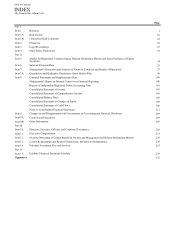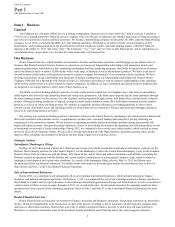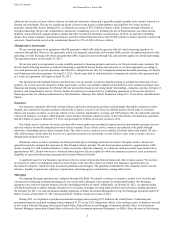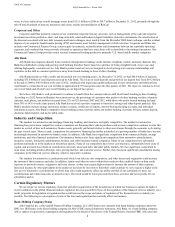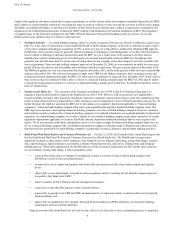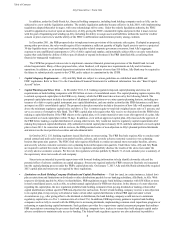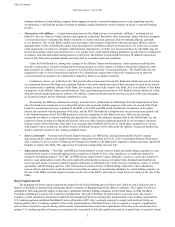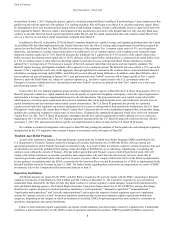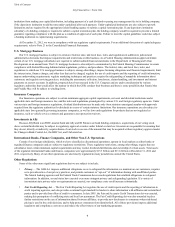Ally Bank 2012 Annual Report Download - page 9
Download and view the complete annual report
Please find page 9 of the 2012 Ally Bank annual report below. You can navigate through the pages in the report by either clicking on the pages listed below, or by using the keyword search tool below to find specific information within the annual report.7
banking subsidiary or bank holding company from engaging in unsafe or unsound banking practices and, depending upon the
circumstances, could find that paying a dividend or making a capital distribution would constitute an unsafe or unsound banking
practice.
• Transactions with Affiliates — Certain transactions between Ally Bank and any of its nonbank “affiliates,” including but not
limited to Ally, are subject to federal statutory and regulatory restrictions. Pursuant to these restrictions, unless otherwise exempted,
“covered transactions” including Ally Bank's extensions of credit to and asset purchases from its nonbank affiliates, generally
(1) are limited to 10% of Ally Bank's capital stock and surplus with respect to transactions with any individual affiliate, with an
aggregate limit of 20% of Ally Bank's capital stock and surplus for all affiliates and all such transactions; (2) in the case of certain
credit transactions, are subject to stringent collateralization requirements; (3) in the case of asset purchases by Ally Bank, may not
involve the purchase of any asset deemed to be a “low quality asset” under federal banking guidelines; and (4) must be conducted in
accordance with safe-and-sound banking practices (collectively, the Affiliate Transaction Restrictions). In addition, transactions
between Ally Bank and a nonbank affiliate generally must be on market terms and conditions.
Under the Dodd-Frank Act, among other changes to the Affiliate Transaction Restrictions, credit exposures resulting from
derivatives transactions, securities lending and borrowing transactions, and acceptance of affiliate-issued debt obligations (other
than securities) as collateral for a loan or extension of credit will be treated as "covered transactions." The Dodd-Frank Act also
expands the scope of covered transactions required to be collateralized, requires that collateral be maintained at all times for
covered transactions required to be collateralized, and places limits on acceptable collateral.
Furthermore, there is an “attribution rule” that provides that a transaction between Ally Bank and a third party must be treated
as a transaction between Ally Bank and a nonbank affiliate to the extent that the proceeds of the transaction are used for the benefit
of or transferred to a nonbank affiliate of Ally Bank. For example, because Ally controls Ally Bank, Ally is an affiliate of Ally Bank
for purposes of the Affiliate Transaction Restrictions. Thus, retail financing transactions by Ally Bank involving vehicles for which
Ally provided floorplan financing are subject to the Affiliate Transaction Restrictions because the proceeds of the retail financings
are deemed to benefit, and are ultimately transferred to, Ally.
Historically, the FRB was authorized to exempt, in its discretion, transactions or relationships from the requirements of these
rules if it found such exemptions to be in the public interest and consistent with the purposes of the rules. As a result of the Dodd-
Frank Act, exemptions now may be granted by the FDIC if the FDIC and FRB jointly find that the exemption is in the public
interest and consistent with the purposes of the rules, and the FDIC finds that the exemption does not present an unacceptable risk
to the Deposit Insurance Fund. The FRB granted several such exemptions to Ally Bank in the past. However, the existing
exemptions are subject to various conditions and, particularly in light of the statutory changes made by the Dodd-Frank Act, any
requests for future exemptions might not be granted. Moreover, these limited exemptions generally do not encompass consumer
leasing or used vehicle financing. Since there is no assurance that Ally Bank will be able to obtain future exemptions or waivers
with respect to these restrictions, the ability to grow Ally Bank's business will be affected by the Affiliate Transaction Restrictions
and the conditions set forth in the existing exemption letters.
• Source of Strength — Pursuant to the Federal Deposit Insurance Act, FRB policy and regulations and the Parent Company
Agreement and the Capital and Liquidity Maintenance Agreement described in Note 21 to the Consolidated Financial Statements,
Ally is required to act as a source of financial and managerial strength to Ally Bank and is required to commit necessary capital and
liquidity to support Ally Bank. This support may be required at inopportune times for Ally.
• Enforcement Authority — The FDIC and FRB have broad authority to issue orders to banks and bank holding companies to cease
and desist from unsafe or unsound banking practices and from violations of laws, rules, regulations, or conditions imposed in
writing by the banking agencies. The FDIC and FRB also are empowered to require affirmative actions to correct any violation or
practice; issue administrative orders that can be judicially enforced; direct increases in capital; limit dividends and distributions;
restrict growth; assess civil money penalties against institutions or individuals who violate any laws, regulations, orders, or written
agreements with the banking agencies; order termination of certain activities of bank holding companies or their subsidiaries;
remove officers and directors; order divestiture of ownership or control of a nonbanking subsidiary by a bank holding company (in
the case of the FRB); terminate deposit insurance (in the case of the FDIC); and/or place a bank into receivership (in the case of the
FDIC).
Basel Capital Accord
The minimum risk-based capital requirements adopted by the federal banking agencies follow the Capital Accord (Capital Accord or
Basel I) of the Bank for International Settlements' Basel Committee on Banking Supervision (Basel Committee). The Capital Accord was
published in 1988 and generally applies to depository institutions and their holding companies in the United States. In 2004, the Basel
Committee published a revision to the Capital Accord (Basel II). The goal of the Basel II capital rules is to provide more risk-sensitive
regulatory capital calculations and promote enhanced risk management practices among large, internationally active banking organizations.
U.S. banking regulators published final Basel II rules in December 2007. Ally is currently required to comply with the Basel II rules as
implemented by the U.S. banking regulators. Prior to full implementation of the Basel II rules, Ally is required to complete a qualification
period of four consecutive quarters during which it needs to demonstrate that it meets the requirements of the rules to the satisfaction of its
primary U.S. banking regulator. Pursuant to an extension that was granted to Ally, this qualification period, or parallel run, is required to begin
Table of Contents
Ally Financial Inc. • Form 10-K


